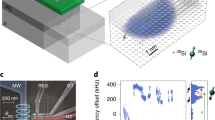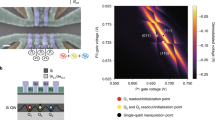Abstract
In the last two decades, a lot of research has been done for finding the best physical implementation of a quantum computer. Due to integrablity with classical computation hardware and versatility in creating qubits and quantum gates, silicon quantum dot-based systems are one of the most promising systems. In this paper, we have modelled a universal Clifford set of single qubit quantum gates based on silicon quantum dots framework by using the Lindblad master equation, where electron spin resonance (ESR) has been employed for manipulation of qubit states. State spin probability evolution of each of the gates has been reported in presence of dephasing effect. Moreover, the density matrix approach and quantum process tomography of each of the single qubit gates has been investigated. Furthermore, it has been shown that by increasing the ac magnetic field, we can obtain a high-fidelity NOT gate for a considerably wider range of static magnetic fields. This provides us with greater control by considering both ac magnetic field as well static magnetic field.










Similar content being viewed by others
References
Xin, T., Wang, B.-X., Li, K.-R., Kong, X.-Y., Wei, S.-J., Wang, T., Ruan, D., Long, G.-L.: Nuclear magnetic resonance for quantum computing: techniques and recent achievements. Chinese Phys. B. 27(2), 020308 (2018)
Sutton, B., Datta, S.: Manipulating quantum information with spin torque. Sci. Rep. 5, 17912 (2015)
Kan, A., Nam, Y.: Lattice quantum chromodynamics and electrodynamics on a universal quantum computer. arXiv:2107.12769 [quant-ph] (2021). https://doi.org/10.48550/arXiv.2107.12769
Gale, E. P, Mehdi, Z., Oberg, L. M., Ratcliffe, A. K., Haine, S. A, Hope, J. J.: Optimized fast gates for quantum computing with trapped ions. Phys. Rev. A. 101, 052328 (2020)
Krantz, P., Kjaergaard, M., Yan, F., Orlando, T.P., Gustavsson, S., Oliver, W.D.: A quantum engineer’s guide to superconducting qubits. Appl. Phys. Rev. 6, 021318 (2019)
Henriet, L., Beguin, L., Signoles, A., Lahaye, T., Browaeys, A., Reymond, G.O., Jurczak, C.: Quantum computing with neutral atoms. Quantum. 4, 327 (2020)
Gunlycke, D., Jefferson, J.H., Rejec, T., Ramšak, A., Pettifor, D.G., Briggs, G.A.D.: Entanglement between static and flying qubits in a semiconducting carbon nanotube. J. Phys. Condens. Matter. 18(21), S851–S866 (2006)
Maruri, G.C., Omar, Y., de Coss, R., Bose, S.: Graphene enabled low-control quantum gates between static and mobile spins. Phys. Rev. B Condens. Matter. 89(7), 075426 (2014)
Habgood, M., Jefferson, J.H., Ramšak, A., Pettifor, D.G., Briggs, G.A.D.: Entanglement of static and flying qubits in degenerate mesoscopic systems. Phys. Rev. B Condens. Matter. 77(7), 1–10 (2008)
Yamamoto, M., Takada, S., Bäuerle, C., Watanabe, K., Wieck, A.D., Tarucha, S.: Electrical control of a solid-state flying qubit. Nat. Nanotechnol. 7(4), 247–251 (2012)
Vandersypen, L.M.K., Bluhm, H., Clarke, J.S., Dzurak, A.S., Ishihara, R., Morello, A., Reilly, D.J., Schreiber, L.R., Veldhorst, M.: Interfacing spin qubits in quantum dots and donors- hot, dense and coherent. npj Quantum Inf. 3, 34 (2017)
Bhat, H.A., Khanday, F.A., Kaushik, B.K., Bashir, F., Shah, K.A.: Quantum computing: fundamentals, implementations and applications. IEEE Open J. Nanotechnol. 3, 61–77 (2022). https://doi.org/10.1109/OJNANO.2022.3178545
Loss, D., DiVincenzo, D.P.: Quantum computation with quantum dots. Phys. Rev. A. 57, 120–126 (1998)
Chen, E., et al.: Advances and future prospects of spin-transfer torque random access memory. IEEE Trans. Magn. 46, 1873–1878 (2010)
Locatelli, N., Cros, V., Grollier, J.: Spin-torque building blocks. Nat. Mater. 13, 11–20 (2014)
Petit, L., Eenink, H.G.J., Russ, M., et al.: Universal quantum logic in hot silicon qubits. Nature. 580, 355–359 (2020)
Nielsen, M.A., Chuang, I.L.: Quantum Computation and Quantum Information. Cambridge Univ. Press, Cambridge, U.K. (2000)
Merle, L., Delpoux, A., Mlayah, A., Grisolia, J.: Multiscale modeling of the dynamical conductivity of self-assembled nanoscale networks: numerical simulations vs anylitical models. J. Appl. Phys. 132, 015107 (2022). https://doi.org/10.1063/5.0097997
Auth, C. et al.: A 22nm high performance and low-power CMOS technology featuring fully-depleted tri-gate transistors, self-aligned contacts and high density MIM capacitors. 2012 Symposium on VLSI Technology (VLSIT), 2012, pp. 131–132. https://doi.org/10.1109/VLSIT.2012.6242496
Zajac, D. et al.: “Single electron spin qubits in silicon quantum dots,” Ph.D. dissertation, Princeton. http://arks.princeton.edu/ark:/88435/dsp01f4752k519
Ansaloni, F., Chatterjee, A., Bohuslavskyi, H., Bertrand, B., Hutin, L., Vinet, M., Kuemmeth, F.: Single-electron operations in a foundry-fabricated array 20 of quantum dots. Nat. Commun. 11, 6399 (2020)
Geck, L., Kruth, A., Bluhm, H., van Waasen, S., Heinen, S.: Control electronics for semiconductor spin qubits. Quantum Sci. Technol. 5, 015004 (2019)
Pla, J.J., et al.: A single-atom electron spin qubit in silicon. Nature. 489(7417), 541–545 (2012)
Veldhorst, M., et al.: Spin-orbit coupling and operation of multivelly spin qubits. Phys. Rev. B. 92(20), 201401 (2015)
Acknowledgments
The research work is supported by University Grants Commission, Government of India in the form of Junior Research Fellowship (MANF-2018-19-JAM-98591).
Author information
Authors and Affiliations
Corresponding author
Additional information
Publisher’s Note
Springer Nature remains neutral with regard to jurisdictional claims in published maps and institutional affiliations.
Supplementary Information
Below is the link to the electronic supplementary material.
Rights and permissions
Springer Nature or its licensor (e.g. a society or other partner) holds exclusive rights to this article under a publishing agreement with the author(s) or other rightsholder(s); author self-archiving of the accepted manuscript version of this article is solely governed by the terms of such publishing agreement and applicable law.
About this article
Cite this article
Bhat, H.A., Malik, G.F.A. & Khanday, F.A. Design and Modelling of Silicon Quantum Dot Based Single Qubit Spin Quantum Gates. Int J Theor Phys 61, 258 (2022). https://doi.org/10.1007/s10773-022-05239-y
Received:
Accepted:
Published:
DOI: https://doi.org/10.1007/s10773-022-05239-y




